Entering the 2019 season, the run defense was a primary concern for Notre Dame. Replacing Te’von Coney, Drue Tranquill, and Jerry Tillery was daunting, as each had been mainstays of strong units in 2017 and 2018 and rarely left the field. Depth charts at linebacker gave fans heart palpitations as players cross-trained and seemed to move up and down with each practice report.
Then everything turned out… mostly fine! Shame on us for doubting Clark Lea – Jeremiah Owusu-Koramoah and Drew White developed into dependable and disruptive players, Asmar Bilal proved haters wrong with a strong season, and Myron Tagavailoa-Amosa and Kurt Hinish were a stout inside combination. By most metrics, the Irish run defense was just as strong as in 2019 – can that success continue into 2020 with key pieces of the front seven returning?
This is the third post in a multi-part series breaking down Notre Dame’s 2019 season – we’ve covered the offense, now it’s time to move to the other side of the ball. As usual garbage time is excluded from these numbers, and for ease in comparing 2018 vs 2019 numbers I’ve included only P5 opponents + Navy. If lost, this handy advanced stats glossary will help if needed.
Past posts, in case you missed them:
No drop-off despite new faces
No matter how much respect you had for Clark Lea, it was an easy choice to pinpoint the Irish run defense as the top reason for worry entering last season. It likely had less to do with Lea and more to do with the loss of multi-year stalwarts like Jerry Tillery, Drue Tranquill, and Te’von Coney. So much preseason analysis also boiled down to “the trip to Athens is frightening” with Deandre Swift and an ultra-experienced and talented UGA offensive line.
There’s a lesson in there as well about reading too much into smoke signals from practice reports – linebacker rotations constantly in flux were misconstrued as “maybe none of our linebackers are any good” or “maybe Asmar Bilal was the victim of a Space Jam style talent theft”. Confirmation bias ran wild in the first two series of the season at Louisville. By the time the sun had set on the season in Orlando, the run defense appeared just as stout as the previous year.

Opponent efficiency and explosiveness measures inched up slightly but remained extremely solid. Offsetting those small declines was an increase in negative plays and overall yards per rush allowed. For a defense that was 95th in weighted returning production, that’s impressive work, especially against three dangerous rushing offenses in Georgia, Navy, and Boston College.
Offenses can take only what Clark Lea gives
One of Lea’s standout features as a defensive coordinator and play-caller is the ability to take things away from opponents. Sometimes this plan is evident from the first series, in other games it comes through clearly in mid-game adjustments. At Georgia, make Jake Fromm push the ball down the field to beat you. Against USC, guard against the pass and dangerous receivers first and force Clay Helton to commit to the run to beat you. Against teams without a real passing threat (Louisville, VT, Duke, BC) contain the dual-threat Quarterback and get them into passing downs they can’t convert.
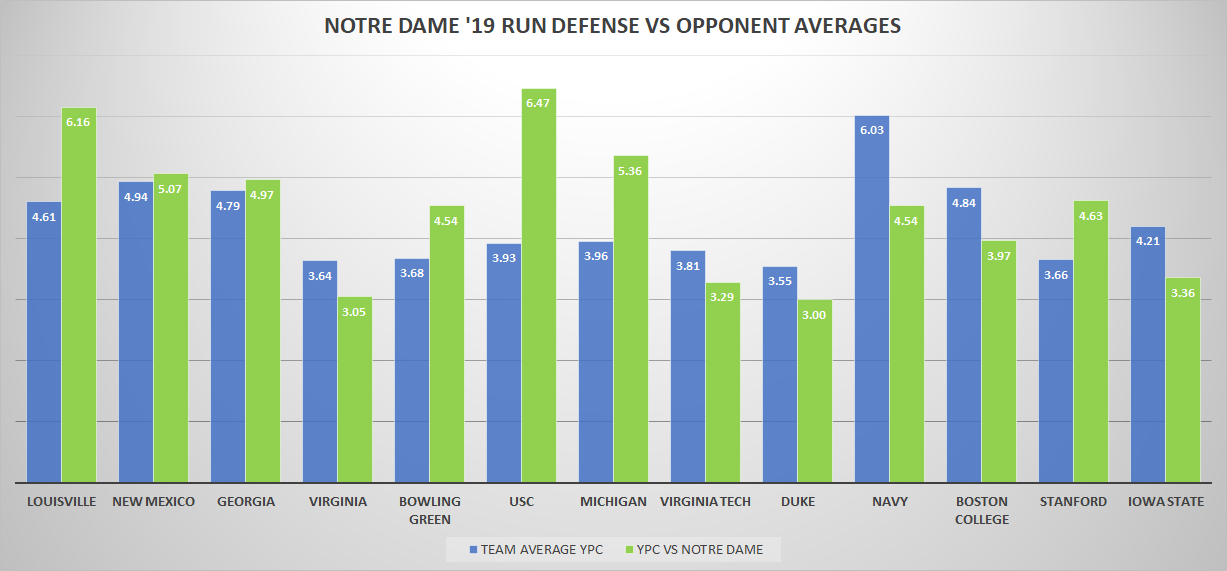
Only four teams meaningfully exceeded their season-long rushing averages against the Irish. USC and Stanford were decisions to prioritize pass defense against teams that hadn’t run the ball consistently and leaned toward airing it out (still strange to say for a David Shaw team). Louisville appeared to have a terrific day on the ground, but their rushing average was slanted by an extremely effective first quarter where the Irish defense looked out of sorts. That was followed by adjustments and the ND defense largely shutting things down for the following 45 minutes. The final game, where a team that had struggled to run at all somehow gashed a defense that had not allowed big rushing plays in two years in a downpour, I have nothing else to say about.
Bend but don’t break worked in big games*
Containing explosive plays has been a bedrock of the Elko/Lea era, and that continued on the ground in 2019. In 11 games against P5 competition and Navy, the Irish gave up just 12 runs of 20+ yards. Defining an explosive run as 12+ yards, the Irish gave up just two at UGA, one versus Bryce Perkins and UVA, two to Navy, and four to USC (despite allowing a high success rate). The Irish run success rates allowed won’t wow anyone, but few opponents were able to rush consistently enough to sustain drives.
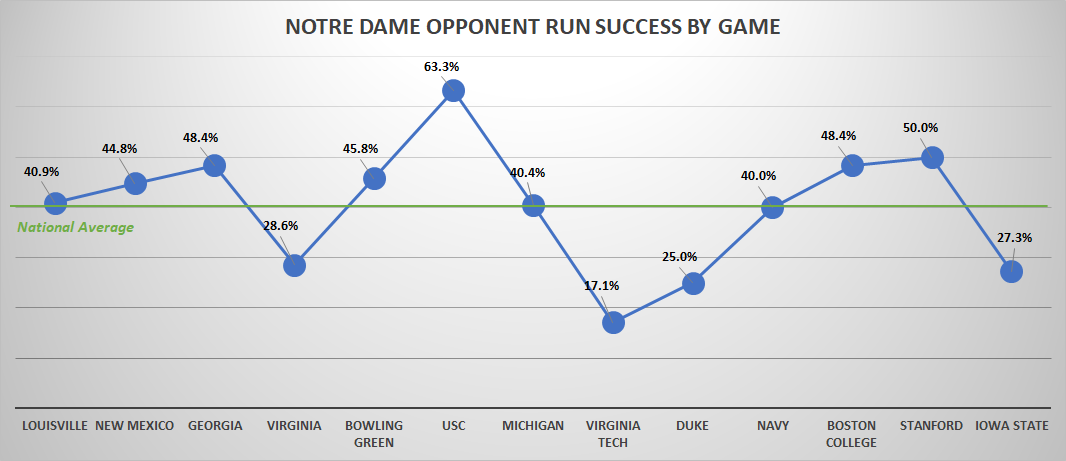
Would it be great to be more dominant limiting opponent success, and consistently below the green line above? Absolutely! But the bend but don’t break formula, especially when you’re terrific on passing downs as the Irish have been past few seasons, can definitely be successful. There just aren’t many opponents that possess the combination of talent, commitment to the run, and potent rushing attack to grind down the latest versions of the Notre Dame defense.
*The obvious asterisk here is again the debacle at Michigan, which I hesitate even acknowledging the existence of. It stands alone as a strange outlier in the Lea era in two regards. First, it’s the only game where the defense was gashed by an opponent of equal or lesser talent. Second, it’s the only time in 2018-2019 that the defense seemed to blink in the face of adversity and lose confidence late in the game.
2020 should bring more of the same – will that be enough?
While Julian Okwara, Khalid Kareem, and Asmar Bilal will be missed, it’s difficult to project Notre Dame’s run defense to fall off with so many key figures returning. The interior defensive line rotation is all back, with four guys who worst-case should demonstrate steady improvement and best case a few make a leap. Kurt Hinish, Myron Tagavailoa-Amosa, Jacob Lacey, and Jayson Ademilola have a strong argument for the best two-deep at defensive tackle in years.
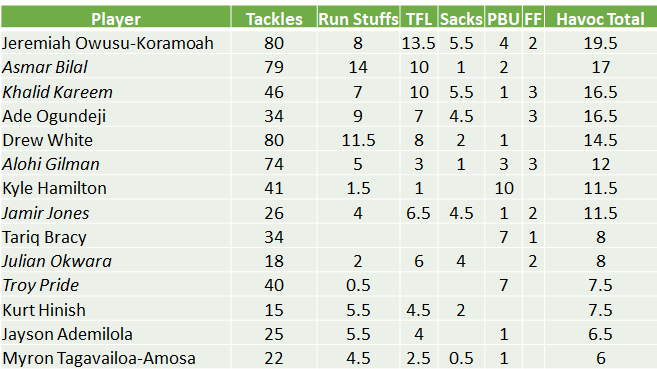
White and Owusu-Koramoah give the linebackers an extremely high floor, with a ton of talented names jockeying for the final starting spot and snaps. While some shuffling may occur, it’s foolish to doubt Clark Lea filling in the rotation and finding ways to optimally deploy Jack Lamb, Bo Bauer, Shayne Simon, Jordan Genmark-Heath, Paul Moala, etc. Daelin Hayes and Ade Ogundeji may not technically be “returning starters” but are proven commodities still with untapped upside. Alohi Gilman and Jalen Elliott will be missed, but Kyle Hamilton cleaning things up on the back end just might be ok.
Independent of the Irish run defense remaining solid and potentially improving, the degree of difficulty is set to go up. Travis Etienne should really be playing on Sundays by this point, and Clemson may increase his workload now with star WR Justyn Ross out for the season. Wisconsin loses Jonathan Taylor, who stands out even in the pantheon of Badger workhorse backs, but it would be foolish to think they won’t be a top-20 rushing offense again. You probably stopped watching Louisville after the opener, but Javian Hawkins rang up 1,525 yards rushing at 5.8 yards a carry last year, and Micale Cunningham can run from QB too. Navy is Navy.
Travis Etienne in 2019:
🏈 7.8 Yards / att (1st)
🏈 5.1 Yards after contact / att (1st)
🏈 91 Forced missed tackles (1st) pic.twitter.com/QzBpzcG3iu— PFF College (@PFF_College) March 23, 2020
Last season the Irish run defense worked well when paired with strong pass defense, especially on passing downs. But with a secondary that has more question marks than a season ago, will the run defense need to step up another level?

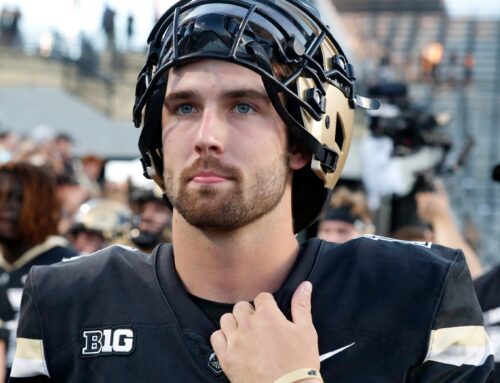
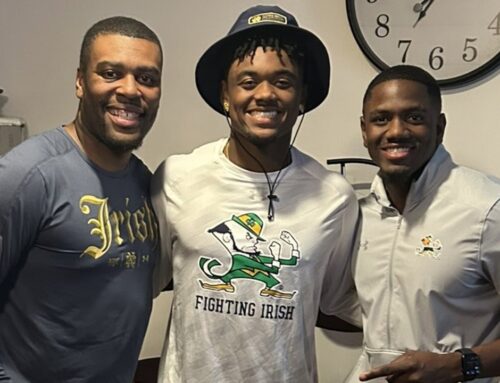

The havoc rate to snaps ratio for Jamir Jones has to be Hall of Fame worthy!
This is unrelated, but saw that the Navy-ND game has officially been moved to Navy–Marine Corps Memorial Stadium in Annapolis for the first time ever. I assumed it would be the smallest capacity stadium ND has played in in recent memory, but looks like Wake’s capacity is ~3,000 fewer.
Moved to Labor Day weekend, too.
Well. Here I am stuck with two tix to the game in Dublin, plus no 18 Stripes party to organize there. Sorry, DC84 Irish, Hooksorpic, and kiwifan. Sigh.
Been to Navy’s stadium, when I was in the Pentagon, think it’s kinda junky.
But the Labor Day weekend start has to be a plus. We need the extra week, and we can also see how the other games the week before go (adjusting to virus conditions).